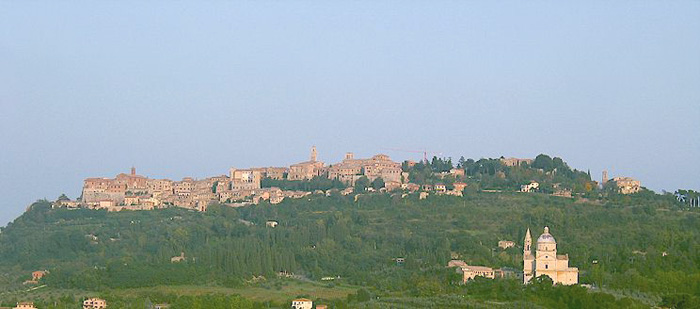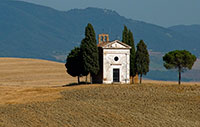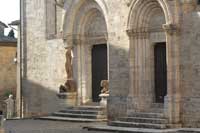| |
|
From the Church of St. Agnese to the Church of St. Agostino and the Torre di Pulcinella
|
|
|
We start our walk in front of the Church of St. Agnese. After skirting the Poggiofanti gardens, we enter the town through the Porta al Prato. Passing the Colonna del Marzocco, the symbol of an alliance with Florence during the rennaisance, we continue our walk past the important buildings of Avignonesi, Cocconi, Bucelli, until we reach the Church of St. Agostino and the Torre di Pulcinella ( a mechanical puppet that chimes the hour on a bell). Higher up on Via Gracciano nel Corso is the Palazzo Avignonesi, with grinning lions’ heads. Farther along the Corso, Palazzo Bucelli (Via di Gracciano nel Corso 73) stands out for its extraordinary exterior. A range of antique sculptures were added to the facade by Pietro Buccelli in the early 1700s (including fragments from Etruscan funerary urns and frieze plaques).
Before embarking on the climb up, you should visit the church of Sant’Agnese, named in honour of a local Dominican abbess, Agnese Segni (1268–1317), who was canonized in 1726 and is buried in the church. The first chapel on the right contains the Madonna di Zoccoli, attributed to Simone Martini (or his school), while the second altar on the left features a fourteenth-century Sienese fresco of the Madonna del Latte. This subject, which shows a breast-feeding Madonna, is a common feature of Sienese (and Tuscan) painting of the period – the Virgin’s milk, in Christian iconography, symbolizing the font of Eternal Life (many a Tuscan church in the Middle Ages claimed to have genuine drops of the Madonna’s milk). The subject vanished entirely following the Council of Trent, which in a fit of Counter–Reformationary zeal banned any use of “unnecessary” nudity in the portrayal of religious characters.[1]
Piazza Savonarola is the home of two elegant palazzi: the Palazzo Avignonesi (the palazzo with the two lion heads flanking the entrance, Via Gracciano nel Corso (no. 91)) and the Palazzo Tusci.
Fattoria di Pulcino occupies the bottom floors of the latter. The self-guided tour of its cellars takes you down into a labyrinth of tunnels complete with casks of wine, medieval weapons and torture implements on display in the empty Etruscan tombs.Across the street is the Palazzo Tarugi (no. 82). Both are by Giacomo Barozzi da Vignola, the late Renaissance architect who designed Rome’s Villa Giulia.[4]
Palazzo Bucelli (no. 73) incorporates a collage of 2,700-year-old Etruscan funerary urns. They represent the collection of 18th-century antiquarian scholar and former resident Pietro Bucelli.
The church of Sant’Agostino was designed around 1427 by the earlier Medici protégé, Michelozzo – who also carved the terracotta relief of the Madonna and Child above the door; within are a Crucifixion on the third altar on the left wall by Lorenzo di Credi and an equally good St Bernardino by Giovanni di Paolo on the right wall. Pride of place goes to a polychrome Crucifix on the high altar attributed to Donatello.
About a hundred metres farther along you reach the Renaissance Loggia di Mercato and a fork in the road: turn right here if you want to make straight for the Piazza Grande. The Corso continues to the left past further palazzi, including the Palazzo Cervini.[1]
|
|
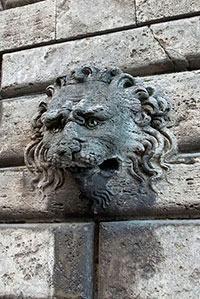
lion heads flanking the entrance of Palazzo Avignonesi
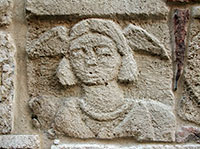
Outside the Bucelli Palace is an unusual foundation made up of tombstone fragments of Etruscan and Roman art
|
From the Church of St. Agostino up to the main square, the Piazza Grande
|
|
|
| The road now rises steeply to Piazza delle Erbe and the Logge del Grano, a palazzo designed in the 15th century by Vignola with an arcaded porch and the Medici balls prominent above the entrance .A steep slope brings us up to the The main road now becomes Via di Voltaia nel Corso, passing Il Capriccio, at no. 14, the town's best gelato vendor, then the grandiose Palazzo Cervini, probably designed by Antonio Sangallo the Younger (Sangallo the Elder's nephew).
The Logge del Grano is found on the Piazza delle Erbe. It is a palazzo designed in the 15th century by Vignola with an arcaded porch and the Medici balls prominent above the entrance.
The elegant Palazzo Cervini with its singular U-shape design, is attributed to Sangallo the Younger. It was built for Marcello II Cervini, pope for only 28 days in 1555.
Palazzo Cervini in Montepulciano (Italy). Address: Via di Voltaia nel Corso 21
We continue our climb towards the Church of Jesus. At this point we turn right and pass under the first city wall, in front of the theatre, and begin our descent towards the home and birthplace of Poliziano.[2]
Angelo Ambrogini, commonly known by his nickname Poliziano was an Italian classical scholar and poet of the Florentine Renaissance. His scholarship was instrumental in the divergence of Renaissance (or Humanist) Latin from medieval norms and for developments in philology. His nickname, Poliziano, by which he is chiefly identified to the present day, was derived from the Latin name of his birthplace, Montepulciano (Mons Politianus).
Poliziano's works include translations of passages from Homer's Iliad, an edition of the poetry of Catullus and commentaries on classical authors and literature. It was his classical scholarship that brought him the attention of the wealthy and powerful Medici family that ruled Florence. He served the Medici as a tutor to their children, and later as a close friend and political confidante. His later poetry, including La Giostra, glorified his patrons.
Via di Poliziano loops outside the walls to the Gothic-fronted Santa Maria dei Servi. Inside it’s visited by devout locals eager to prostrate themselves before the much venerated Madonna della Santoreggia, a fifteenth-century fresco (second altar on the left). Via di Poliziano then re-enters town by the old Fortezza, now partly occupied by houses.
From its high perch the imposing Medici fortress dominates the town.
After it became a free municipality at the beginning of the 14th century, Montepulciano was contested at length between Siena and Florence before it finally became the established property of the Medici family in 1511.
At the end of Via di San Donato, the last quiet stretch back into town, you’ll find yourself in the cathedral and town hall square, Piazza Grande.[1]
|
|
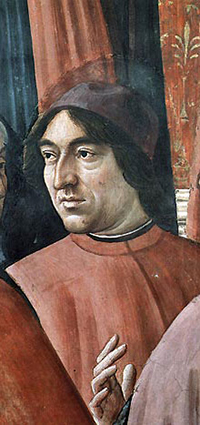
|
Angelo Poliziano, one of the four humanist philosophers under the patronage of the Medici.
Domenico Ghirlandaio: Zachariah in the Temple [detail], fresco in the Cappella Tornabuoni, Santa Maria Novella, Florence
|
We walk uphill towards the highest point in the town, entering through the Porta di San Donato, passing the Fort and finally arriving in the main square, the Piazza Grande. Here we find the Duomo (cathedral), the Palazzo Comunale (the town hall), the Tarugi and Contucci palaces (which posseses one of the oldest unde'rground cellars of the town ), the Pozzo dei Grifi e dei Leoni (well of the griffons and lions ). The bell tower (unfinished) is still the Medieval one of the pre-existent Pieve. The Cathedral holds several masterpieces: the Assumption of the Virgin triptych painted by Taddeo di Bartolo in 1401; Michelozzo's Aragazzi funeral monument (1427-1437) which fragments can be seen close to the main door and at the altar (two statues and the frieze with little angels); the Madonna del Pilastro by Sano di Pietro (15th century); the polychrome terracotta altar by Andrea della Robbia (1521) behind a 14th century baptismal font.
Two of the palazzi on the square were designed by Sangallo. The Palazzo Nobili-Tarugi, by the lion and griffon fountain, is a highly innovative building, with a public loggia cut through one corner; it originally had an extension on the top floor, though this has been bricked in. More tangible pleasures await at the Palazzo Cantucci, one of many buildings scattered about the town that serve as cantine for the wine trade, offering degustazione and sale of the Vino Nobile. The lower part is by Sangallo, the upper by Baldassare Peruzzi, who was Siena’s leading sixteenth-century architect.'[1]
Piazza Grande. On the left is the Palazzo Comunale, designed by Michelozzo as a late-14th-century homage in travertine to Florence's Palazzo Vecchio. (Teens may recognize it from the 2009 vampire movie Twilight: New Moon — filmed here, despite being set in Volterra.)
To your left is the Palazzo Nobili-Tarugi, with an arcaded loggia on the corner facing a well topped by the Medici arms flanked by two Florentine lions and two Poliziani griffins. Both the palace and well are the design of Antonio Sangallo the Elder, as is the Palazzo Contucci across from the Palazzo Comunale
The Nobili-Tarugi Palace is located in front of the Cathedral and was attributed to Antonio da Sangallo Il Vecchio, who would build in ‘500. The palace was the residence of the Nobili Family and later of the Tarugi Family. The palace is not open to the public.
'The last side of Piazza Grande is taken up by the rambling brick nonfacade of the 17th-century Cattedrale di Santa Maria Assunta, a somewhat embarrassing reminder to Poliziani (?) that, after building so many palaces and fitting so many of them with travertine, the city ran out of money to finish the ambitious plans for rebuilding the cathedral and had to leave it faceless. To the left of the church, the suspiciously 1950s-looking bell tower is actually the oldest thing on the piazza, dating from the 14th century and the cathedral of Santa Maria that once stood here. Inside, the Duomo makes up for its plain facade with two important works. The first takes some explaining because it's scattered in pieces around the church. Between 1427 and 1436, Michelozzo carved a monumental tomb for Bartolomeo Aragazzi, secretary to Pope Martin V. In the 18th century it was disassembled and the pieces lost until they were discovered under the altar of the Duomo in 1815. Two of the figures were stolen and found their way to London, but the rest remain here. Because no indication of what the monument originally looked like exists and the supporting architecture is gone, the various figures are distributed throughout the church. They start with a reclining statue of the deceased to the right of the central entrance door (he's the one with the hood) and two bas-reliefs on the first two columns on either side of the nave. The Greco-Roman-influenced statues flanking the high altar and the putti frieze above it, along with a statue in a niche to the right of the altar, are the other main pieces.
The gold-heavy triptych on the high altar is by Taddeo di Bartolo (1401) and depicts the Assumption of the Virgin with Saints topped by Annunciation and Crowning of the Virgin pinnacles, and is banded with a Passion cycle in the predella. Bartolo was one of the Sienese artists of the generation after the 1348 Black Death, and this is one of his greatest works. (We particularly enjoy the predella panel where one child is shinning up a tree to get a better view of Christ entering Jerusalem.) On a pilaster to the right of the altar is a schiacciato bas-relief tabernacle by Vecchietta. Also inside the Duomo, as you walk out on the right, is an almond-eyed Madonna and Child (1418) by Sano di Pietro, located on the pilaster between the first two chapels. In the last chapel stands a 14th-century baptismal font with bas-relief and caryatid figures and, on the wall, della Robbia's Gigli Altar surrounding a gilded marble bas-relief of the Madonna and Child by Benedetto di Maiano.[3]
Walk from Pozzo dei Grifi e dei Leoni to the beautiful church of San Biagio on the outskirts of town
|
|
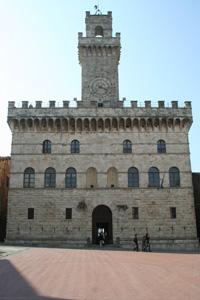
Montepulciano, Palazzo Communale
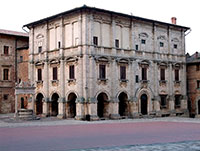
Palazzo Nobili-Tarugi
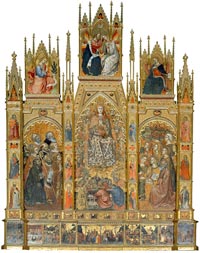 Taddeo di Bartolo, Assumption of the Virgin, Duomo Taddeo di Bartolo, Assumption of the Virgin, Duomo
|
Descending between the palaces of Capitano, Ricci (now a library) and Neri-Orselli (that now houses the civic museum ) we reach the piazza of San Francesco, a beautiful panoramic spot that has a perpendicular drop over the rock, known as the sasso, which holds up the highest part of the town. Descending once again towards the Porta del Paolino, two sharp turns take us to the Porta de’ Grassi, and we leave the town centre to begin our walk down towards the Tempio di San Biagio, a magnificent 6th century construction of Sangallo. Antonio da Sangallo’s greatest commission came in 1518, when he was invited by the town’s Ricci nobles to design the pilgrimage church of San Biagio on the hillside below the town.
'Outside the walls is Antonio da Sangallo the Elder's Tempio di San Biagio (1518-34), one of the undisputed masterpieces of High Renaissance architecture. It became fashionable in the High Renaissance to build a church, usually on a Greek cross plan, just outside a city so that the classically inspired architecture would be unimpaired by surrounding buildings and the church could be appreciated from all angles. Todi and Prato each have their own version, but Montepulciano's is the best of the lot, a pagan temple built entirely of travertine, dedicated to the gods of mathematical and architectural purity and only nominally to any saint. Two bell towers were to have been fitted into the corners at the front, but the right one reached only 4.5m (15 ft.). The interior, while as peaceful and elegantly restrained as the overall structure, has nothing to hold you. Sangallo also designed the companion canon's house nearby, which was built after his death.[3]
|
|
|
| |
|
|
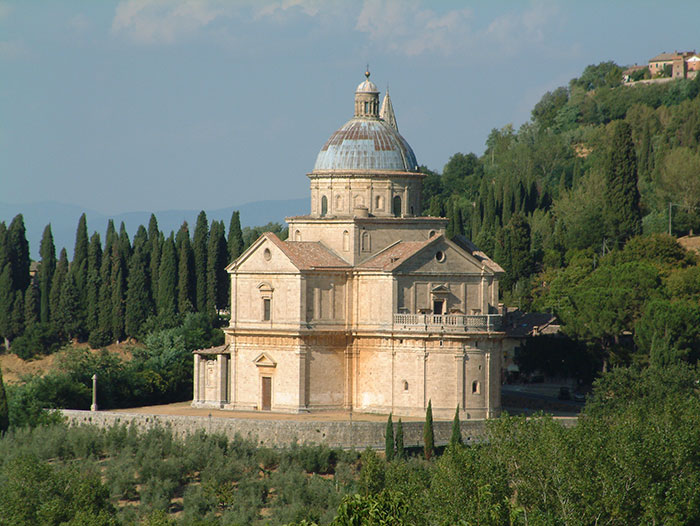 |
The unusual Basilica di San Biagio built by Sangallo in the XVI century [Photo, Josep Renalias]
|
From the Church of San Biagio back to Piazza Savonarola and the small piazza above the Porta al Prato
|
|
|
We walk down a lane planted on both sides with tall cypresses, each one in memory of a soldier from Montepulciano who died during the First World War. We take a steep uphill left turn ( also shaded by cypresses ) and arrive back in town through the Porta di Collazzi.
We continue to the end of this road where we reach the splendid 5th century Cantina del Redi (Redi cellars), located under the Ricci palace.
The area around Montepulciano has been known since at least the 8th century for its superior wine, and in the 17th century, when Francesco Redi wrote his vino-praising poem, Bacchus in Tuscany, he described the Noble Wine of Montepulciano as “the king of all wines.”
We descend again and turning right find ourselves in front of the Church of St. Lucia. Once more walking downhill we arrive in front of St. Agostino. We turn right and find ourselves at another panoramic spot on the city walls, and then come out in front of the Colonna del Marzocco. (La colonna reca alla sommità il leone fiorentino che nel 1511 fu posto a sostituzione della lupa senese, a testimonianza del definitivo assoggettamento della città a Firenze, dopo i 26 anni di dominazione della Repubblica senese.)
|
|
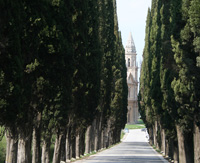 |
We turn right into Piazza Savonarola where we find the Church of St. Bernardo, a Baroque-taste work by Padre Andrea Pozzo, and then enter a small alley way which leads us to a small piazza above the Porta al Prato. From the walls we can see the place from where our tour began, St. Agnese and the Poggiofanti gardens.
|
|
|
| |
|
|
 |
|
|
On top of a high solitary hill facing Montepulciano, stands a very characteristic medieval village of Tuscany: Montefollonico. The splendid isolation of Montefollonico is probably what makes it particularly charming and appealing. Located between the Val d’Orcia and the Val di Chiana valleys, southeast of Siena, the town holds very ancient origins.
The hike from Montepulciano to Montefollonico takes about three hours. You exit Montepulciano by the old portal closest to St. Biagio church, walking down the hill toward St. Biagio. You walk just past the church on its left and then loop around the church to the right on a paved town road that becomes a paved country road.
If you follow the directionsbelow (or the description in the book Walking and Eating in Tuscany), you will have no issues.
Walking in Tuscany |Walking From Montepulciano to Montefollonico and back
Walking from Montepulciano to Montefollonico, the Ruins of Santa Maria and Il Tondo | 17 km
Circular walk Montefollonico | 6 km
Maps and further descriptions are available in Podere Sante Pia.
|
|
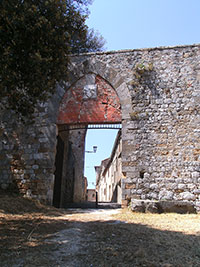
Montefollonico, Porta Triano
|
|
| Montepulciano city walk
|

Montepulciano
|
|
|
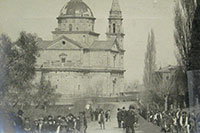 |
|
 |
|
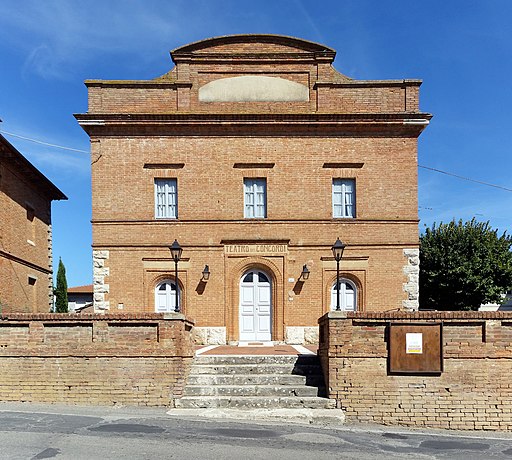 |
San Biagio, Montepulciano, foto storica
|
|
Palazzo Nobili-Tarugi, Montepulciano
|
|
Teatro della Società dei Concordi |
| Chiesa di San Biagio |
|
|
 |
|
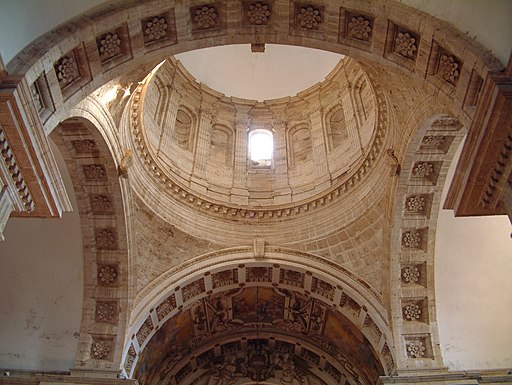 |
|
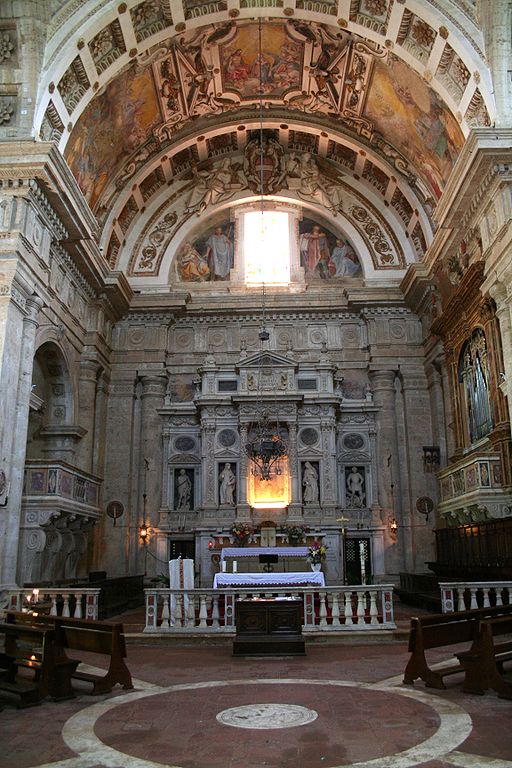 |
San Biagio, esterno
|
|
San Biagio, cupola
|
|
Chiesa di San Biagio, interno |
 |
|
|
Trekking Val d'orcia
Strada del Vino Nobile di Montepulciano | Wines in Tuscany
Montepulciano is a major producer of food and drink. Renowned for its pork, cheese, "pici" pasta, lentils, and honey, it is known world-wide for its wine. Connoisseurs consider its Vino Nobile, which should not be confused with varietal wine merely made from the Montepulciano grape, among Italy's best.
Comune Montepulciano
Download Montepulciano map | www.mappery.com |
|
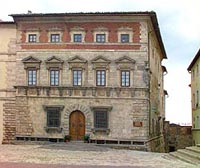
Palazzo Contucci. The Contucci family was one of the "founding fathers" of Vino Nobile
|
|
Magically set amid the magical splendid countryside south of Siena, Podere Santa Pia is a beautiful Renaissance villa, wonderfully turned into a holiday home. The location of the old cloister is actually amazing, being in the heart of the Maremma territory, one of the most beautiful and spectacular landscapes of all Italy.
The landscape, characterized by soft barren hills, lonely downey oak and cypress trees, isolated farms on top of the hills, forests stretching in the valleys, is one of the most beautiful and suggestive of all Tuscany.
Podere Santa Pia is located on the edge of the green hills of the Val d'Orcia and the Valle d'Ombrone begins, and one can easily reach some of the most beautiful attractions of Tuscany, such as Montalcino, Pienza, Montepulciano and San Quirico d'Orcia. Monticchiello is a beautiful fortified little hamlet offering a spectacular vista over the Renaissance city of Pienza, renowned for its delicious pecorino cheese and for the beauty of its historical center.
Podere Santa Pia is a fully equipped 4 bedroom holiday home. The 4 bedrooms are very elegant, all having a special romantic and intimate atmosphere. They are furnished with the greatest attention to details, with precious paintings and textiles. Each room is unique, and all rooms enjoy a breathtaking view over the enchanting garden and the surrounding weaving hills.
This is the land where the DOC wines Montecucco, Vino Nobile di Montepulciano and Brunello di Montalcino are produced. So, the surrounding countryside is the ideal area for an uncommon wine tour. While staying at the house you can delight in the culinary specialties and delicacies of some of the best restaurants in Tuscany, serving unique Tuscan dishes accompanied by great wines.
Visit our special offers page or contact us.
|
|
|
|
|
|
Podere Santa Pia |
|
Podere Santa Pia |
|
Madonna di Vitaleta Chapel, San Quirico d'Orcia
|
|
|
|
|
|
Pienza |
|
Montalcino |
|
San Quirico d'Orcia
|
Restaurants in Montepulciano
Le Logge del Vignola
via delle Erbe 6 I - 53045 Montepulciano
http://www.leloggedelvignola.com/
Closing: tuesday.
La Grotta
Via di San Biagio
Opposite San Biagio church, about 1km outside the city walls. La Grotta serves pricey classic Tuscan cuisine in a sixteenth-century building with its own garden. Closed Wednesday.
www.lagrottamontepulciano.it/
La Bottega del Nobile
Via Di Gracciano Nel Coso 95, Montepulciano
www.vinonobile.eu
Ristorante Villa Nottola
SS 326 Loc. Nottola, 15, 53045 Montepulciano
www.ristorantevillanottola.com
Osteria Porta di Bacco
Via di Gracciano nel Corso
Just inside the Porta al Prato, this quiet, characterful old stone-arched place.
Closed Tuesday.
Osteria Acquacheta
Via del Teatro 22, 53045 Montepulciano
http://www.acquacheta.eu/
Piccola Trattoria Guastini
Via Lauretana Nord, 20, 53045 Valiano, Montepulciano
http://www.piccolatrattoriaguastini.it/
Caffè Poliziano
Via di Voltaia nel Corso 27.
An 1868 tearoom restored to a classic Art Nouveau design.
Restaurants in Montefollonico
Ristorante dei 13 Gobbi
Via Lando di Duccio, 5, 53040 Montefollonico
Osteria La Botte Piena
Piazza Dionisa Cinughi, 12, 53040 Montefollonico | www.labottepiena.com
Relais La Costa
Via Coppoli, N. 11 al N. | Centro Historico, Montefollonico | www.lacosta.it
La Costa was the old village farm and was owned by the Marquis Scipione Bargagli, the Prime Minister under the Tuscan Grand Duchy Pietro Leopoldo II, as attested in numerous documents preserved by the present owners. The farm played a primary role in selecting and preserving the products of the various "estates", plots of land with a house alongside and run by a family of sharecroppers or mezzadri (the traditional Tuscan manner of running an estate: half the harvest to the owner and half to the worker), there being as many as 30 in the 18th century, under the surveillance of a "bailiff" (a man trusted by the feudal lord-owner) as well as offering work for farm workers and, if needed, protection for the inhabitants of Montefollonico.
Ristorante La Chiusa di Dania Masotti
Via della Madonnina, 88 - 53040 Montefollonico (SI)
La Chiusa is an old stone farmhouse whose restaurant is so well known that guests come from far and wide. Dania and Umberto Lucherini are the gracious owners and Dania is the talented chef. The emphasis here is definitely on the exquisite meals, but there are also bedrooms for guests who want to spend the night.
Dania Masotti is one of the 2 owners and chief of the kitchen from the famous restaurant "La Chiusa" in Montefollonico. "La Chiusa" is one of the best restaurants in Tuscany, located in a former oil-mill.
Together with author Yvonne Tempelmann Dania Maotti has published 2 cookbooks with culinary specialities of the Italian kitchen.
Al Botteghino
Localita' Osteria Delle Noci 25, 53049 Montefollonico

[1] Source: The Rough Guide to Tuscany and Umbria, pp .417-420
[2] See also: Art in Tuscany | Domenico Ghirlandaio | The Tornabuoni Chapel and Poliziano.
Società editrice Fiorentina (1910) mentiones: "The admirable frescoes now to be seen are by Domenico Ghirlandaio : they were executed by order of John Tornabuoni and costed more than 1000 gold florins...The patriarch Zachariah in the Temple : the four half-figures at left hand are the portraits of Agnolo Poliziano, Cristopher Landino, (in red cloak), Demetrius Calcondila, and Marsilio Ficino, (in purple robe)"
The Florentine classical scholar and poet, as well as one of the revivers of Humanist Latin, Angelo Poliziano was born in Montepulciano on July 14, 1454.
Linda Proud's The Botticelli Trilogy centres on the life of Angelo Poliziano. The second volume in particular, Pallas and the Centaur (2004), deals with his boyhood in Montepulciano, and the life of his sister Maria. The novel contains vivid detail of the city and surrounding country and an authoritative account of the murder of Poliziano's father derived from local knowledge.
[3] Read more: www.frommers.com
[4] The Italian architect Giacomo da Vignola (1507-1573) was the most important representative of Bramantesque classicism in the mid-16th century. Born in the town from which he takes his name, Vignola studied in Bologna and was trained as a painter and perspectivist.
Vignola went to Rome in 1530 and was active as a painter and, from the mid-1530s, as an architect. He worked in the Vatican under Peruzzi and Antonio da Sangallo the Younger, who also helped to form his architectural style.
In 1550 Giacomo Barozzi da Vignola was appointed architect to Pope Julius III and designed the Villa Giulia (in collaboration with Vasari). It was a summer villa based on the garden letters of Pliny the Younger. In 1554 he designed the first church with an oval dome (S. Andrea). After the death of Julius III, Vignola worked mainly for the Farnese family. He designed the Villa Farnese at Caprarola and was also involved with the Villa Lante. Vignola was a dominant infulence on Mannerist gardens and architecture.
|
This article incorporates material from the Wikipedia articles Montepulciano and Poliziano, published under the GNU Free Documentation License, and Walking From Montepulciano to Montefollonico
|
| |
|
| |
|
|










